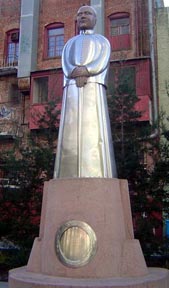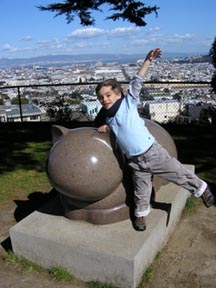Tim. Thanks for the thoughts about Benjamin Bufano from San Francisco. I just threw out the idea of vernacular public art without understanding where it is going. Vernacular is something that appears to sprout from the place and feels so at home that most travelers ignore it. But art requires a little uncomfortable sand in the face.
Your definition of vernacular is to merge with the life of the place. The art is USED. But not to sit on and not to look at, but for the natural imagination of humans. The imaginative use is performed by children and therefore vibrant by nature. For adults, the imaginative uses include conversations, destinations, memories and daydreams. Like all things we use, we only grab them when necessary – not every time we pass by.
I guess at the Randall Garden, the Bufano sculptures have been saved from the vernacular. They have given up their complexity of uses and now stand as simple symbols of another time, place and people. Or merely art. Merely art can be fabulous, but it is still just one-dimensional.

I think the Lapidus follies are still alive with use. No one is trying to isolate them. They breathe among the people. First the Miami Beach middle class of the 1960s, then poor and criminals of the 1980s and now the “be seen” crowd of rich and dressing rich. This longevity and transfer from one people to another is not possible to predict at the beginning. Artist make, administrators install and life proceeds without either.
To see good documentation of Bufano’s work, visit www.mistersf.com and search on “Bufano”. Hank Donat is Mister SF.
Below from Tim Barrus
I do not know if the art of Benjamin Buffano fits into the notion of art-as-the-vernacular, but Buffano’s amazing sculptures became a part of our ordinary if embattled lives living in San Francisco in the 1970s where I raised my daughter as a single parent.
The sculptures themselves were commissioned by the San Francisco Housing Authority in the 1940s. They were climbed on and loved by countless children for fifty years where they loomed over despair, drug dealers, gang violence, boom boxes, low-riders, gun fights, and all the rest of urban life as it is lived by the boxed and dispossessed.

Playing with Bufano
More Barrus. Please read.
Barrus continues
They were one small ray of joy in a toddler’s life as the children from the housing projects they were set in used them like jungle gyms.
I am sure there are other examples of this, but this is the only example I am aware of where government included the notion of high art for those who might not know what it was aesthetically versus the aesthetic notion of providing the rich with public art.
Art as social and class statement.
You bet.
Those public housing projects themselves failed the poor and they were demolished a couple of years ago. The Buffano statues were moved to the Randall Museum garden where I assure you no children climb on them.
As a photographer, I could always hang out around the sculptures and get great shots of poor kids dressed literally in rags playing on the sculptures, and in the background of the photos there is always the inevitable growl of the drug dealing and the violence that was, too, a part of the lives of the children who grew up in those housing projects. There was an irony and a contradiction to the reality of softly-rounded sculptures of madonnas (nurturing hordes of small children) right smack dab next to total urban decay and human destruction in no uncertain terms.
I have often wondered if any of that art really touched any of those lives and now I know it touched one. Mine.
My eye and the eye of the kids who regarded those pieces of art as theirs was always drawn to the sculpture. And our eyes, too, were always looking over our shoulders in anticipation of the murderous violence that could spill our way from the public housing parking lot next to the Buffano sculptures.
New public housing has been built. There is no art.
But the contradiction and the reality of the urban dramas and the destruction of human life in those places we have essentially abandoned continues as do our failures as a society. We fail them and we fail us.
Poor children need art perhaps more than they need social workers. Yet there is no art for them in their new and modern play spaces and there is no more art for them in an educational system everyone agrees is overwhelmed and broken.
The power of public art communicates that there are other possibilities.
It is a tragedy that most of it fits into environments built for the people who need it the least but who can afford the idea of their lives and living spaces being molded around art.
Now when I go to the Randall Museum and see those sculptures in the garden, the place feels haunted, silent, and alone. There are no children screaming, crying, laughing, playing guns and cowboys on the Madonna. Where once the sculptures were part and parcel of an ordinary if murderous landscape, what is left of that “redeveloped” landscape is ordinary, dehumanizing, and just as murderous as ever if not more so. How tragic that now the vernacular is the gentrified in a place where the only thing that has really changed is the class and economic status of the people who now get to experience art that was once a playground. Today what we teach the children of those housing projects is that it is hopelessness that truly endures. It is hopelessness that has become the vernacular of their lives.
Tim Barrus
